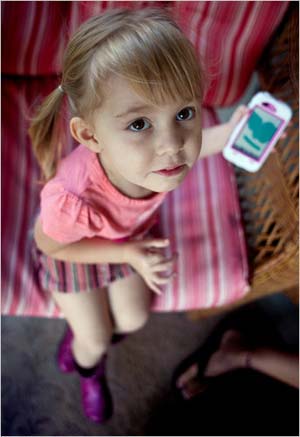|
 Bella Giroux-Nix, 3, has mastered her mother’s iPhone. |
|
Just as adults have a hard time putting down their iPhones, so the device is now the Toy of Choice for many 1-, 2- and 3-year-olds. It’s a phenomenon that is attracting the attention of some childhood development specialists. Natasha Sykes, a mother of two in Atlanta, remembers the first time her daughter, Kelsey, then barely 2 years old, held her husband’s iPhone. “She pressed the button and it lit up. I just remember her eyes. It was like ‘Whoa!’ ” The parents were charmed by their daughter’s fascination. But then, said Ms. Sykes, “She got serious about the phone.” Kelsey would ask for it. Then she’d cry for it. “It was like she’d always want the phone,” Ms. Sykes said. Apple, the iPhone’s designer and manufacturer, has built its success on machines so simple andintuitive that even technologically befuddled adults can figure out how to work them, so it makes sense that sophisticated children would follow. Tap a picture on the screen and something happens. What could be more fun? Many iPhone apps on the market are aimed directly at preschoolers, many of them labeled “educational,” such as Toddler Teasers: Shapes, which asks the child to tap a circle or square or triangle; and Pocket Zoo, which streams live video of animals at zoos around the world. There are “flash cards” aimed at teaching children to read and spell, and a “Wheels on the Bus” app that sings the popular song in multiple languages. Then there’s the new iGo Potty app, with automated phone calls reminding toddlers that it’s time to “go.” Along with fears about dropping and damage, however, many parents sharing iPhones with their young ones feel nagging guilt. They wonder whether it is indeed an educational tool, or a passive amusement like television. The American Academy of Pediatrics has long advised parents not to let their children watch any TV until they are past their second birthday. Jane M. Healy, an educational psychologist in Vail, Colo. said: “Any parent who thinks a spelling program is educational for that age is missing the whole idea of how the preschool brain grows. What children need at that age is whole body movement, the manipulation of lots of objects and not some opaque technology. You’re not learning to read by lining up the letters in the word ‘cat.’ You’re learning to read by understanding language, by listening. (Read by Renee Haines. Renee Haines is a journalist at the China Daily Web site.) (Agencies) |
就像成年人很難做到不玩iPhone一樣,如今iphone也成了許多一歲、兩歲、三歲的幼童的首選玩具。這一現象正在引起一些兒童發展專家的注意。 住在亞特蘭大的娜塔莎?賽克斯是兩個孩子的母親。她記得自己的女兒凱爾西才剛兩歲大,就開始玩她丈夫的iPhone。“她按下了按鈕,屏幕亮了起來。她的眼神我記得很清楚。好像在說‘哇哦!’”。 這對父母被女兒的癡迷吸引了。不過,賽克斯太太說從那以后“她開始對這個電話上癮了”。 凱爾西會主動要iPhone。后來還會哭著鬧著要。賽克斯太太說:“她好像老是要玩這個電話。” 這種簡單又直觀的小機器鑄就了iPhone設計者和制造者蘋果公司的成功,甚至連技術白癡型成年人都知道怎么使用它,所以如果早熟的孩子會用它也就不難理解。輕輕叩擊屏幕上的一張圖片,就會看到一些事情發生。還有什么會比這更有趣呢? 市場上的許多iPhone應用程序都是直接面向學前兒童的,許多程序都貼上了“教育”標簽,例如“學步幼童趣味挑戰題:形狀”,這種程序讓小孩點擊圓圈、正方形或三角形;還有“袖珍動物園”,這種程序播放在世界各地的動物園錄制的動物視頻。 還有“閃卡”程序,目標是教孩子們閱讀和拼寫,以及“公車上的輪子”,這種程序用多種語言播放流行歌曲。此外還有最新的iGo Potty(我去用便盆)程序,有自動來電提醒學步兒童是時候去“方便”了。 然而,除了害怕孩子會把iPhone掉到地上摔壞之外,許多給孩子玩iPhone的父母還會一直有種內疚感。他們想知道這到底是教育工具,還是和電視一樣的消極的娛樂活動。 長期以來,美國兒科學會一直建議父母們在孩子滿兩周歲之前不要讓他們看任何電視節目。 科羅拉多州維爾鎮的一位教育心理學家簡?M?希里說:“任何認為拼寫節目對這一年齡段兒童有教育意義的父母都是不懂學前兒童大腦是如何發育的。” 那個年齡段的小孩所需要的是全身的運動,能夠把玩各種東西,而不是掌握一些難懂的技術。你不是通過排列單詞cat里的字母來學習閱讀,而是通過理解語言、通過聽來學習閱讀。 相關閱讀 (中國日報網英語點津 陳丹妮 編輯:馮明惠) |
|
Vocabulary: intuitive: easily understood or grasped by intuition(直觀的) nagging: continuing for a long time and difficult to cure or remove(糾纏不休的;難以擺脫的) opaque: difficult to understand; not clear(難懂的;隱晦的) |
